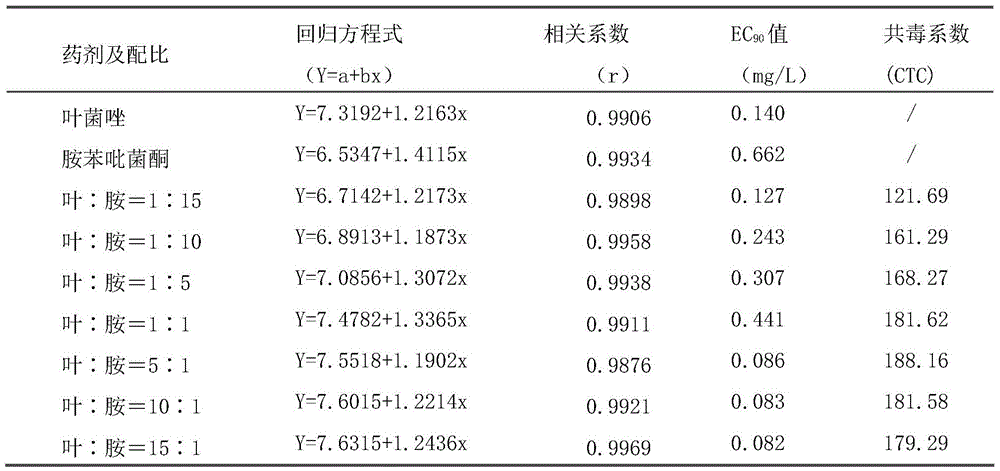A bactericidal composition containing metconazole and amfenpyrone and its application
A technology of Metconazole and Metconazole, which is applied in the direction of fungicides, biocides, applications, etc., can solve the problem of no combination of Metconazole and Metconazole, and reduce the use of pesticides Dosage and cost, improved bactericidal effect, and excellent control effect
- Summary
- Abstract
- Description
- Claims
- Application Information
AI Technical Summary
Problems solved by technology
Method used
Image
Examples
example 1
[0022] In-kind measurement example 1: The virulence measurement of the compound pair of metconazole and fenflurzone against rose rust
[0023] 1. Test object: rose rust fungus [Latin scientific name: Phragmidium mucronatum (Pers.) Schl.]
[0024] 2. Test method: Refer to the "Pesticide Indoor Bioassay Test Guidelines NY / T 1156.15-2008", using the plate method.
[0025] 3. Data statistical analysis: use SAS 6.12 statistical software for analysis. Calculate the control effect (%) according to the test data, and obtain the virulence regression equation, correlation coefficient (r), EC 90 And co-toxicity coefficient.
[0026] 4. Evaluation method: Refer to "Pesticide Laboratory Bioassay Test Guidelines NY / T 1156.15-2006", and evaluate the synergistic effect of the mixture of chemicals according to the Co-toxicity Coefficient Method (CTC) of Sun & Johnson (1960), that is, CTC ≤ 80 is the antagonistic effect , 80 <CTC <120 is additive, and CTC≥120 is synergistic.
[0027] 5. Results and ana...
example 2
[0032] Physical test example 2: The virulence test of the compound pair of metconazole and fenflurzone against Phyllostachys variabilis
[0033] 1. Test object: Asparagus leaf spot pathogen [Latin scientific name: Ramularia asparagi Z.Y.Zhanget W.Q.Chen]
[0034] 2. Test method: Refer to "Pesticide Indoor Bioassay Test Guidelines NY / T 1156.2-2006", and use the drug-containing medium method.
[0035] 3. Data statistical analysis: use SAS 6.12 statistical software for analysis. Calculate the mycelial growth inhibition rate (%) according to the test data, and obtain the virulence regression equation, correlation coefficient (r), EC 50 And co-toxicity coefficient.
[0036] 4. Evaluation method: Refer to "Pesticide Laboratory Bioassay Test Guidelines NY / T 1156.2-2006", and evaluate the synergistic effect of the mixture of drugs according to the Co-toxicity Coefficient Method (CTC) of Sun & Johnson (1960), that is, CTC ≤ 80 is the antagonistic effect , 80
example 3
[0042] In-kind test example 3: Toxicity test of the compound pair of metconazole and fenflurzone against Botrytis cinerea
[0043] 1. Test object: Botrytis cinerea [Latin scientific name: Botryotinia tulipgeseriana]
[0044] 2. Test method: Refer to "Pesticide Indoor Bioassay Test Guidelines NY / T 1156.2-2006", and use the drug-containing medium method.
[0045] 3. Data statistical analysis: use SAS 6.12 statistical software for analysis. Calculate the mycelial growth inhibition rate (%) according to the test data, and obtain the virulence regression equation, correlation coefficient (r), EC 50 And co-toxicity coefficient.
[0046] 4. Evaluation method: Refer to "Pesticide Laboratory Bioassay Test Guidelines NY / T 1156.2-2006", and evaluate the synergistic effect of the mixture of drugs according to the Co-toxicity Coefficient Method (CTC) of Sun & Johnson (1960), that is, CTC ≤ 80 is the antagonistic effect , 80
[0047] 5. Results and...
PUM
 Login to View More
Login to View More Abstract
Description
Claims
Application Information
 Login to View More
Login to View More - R&D
- Intellectual Property
- Life Sciences
- Materials
- Tech Scout
- Unparalleled Data Quality
- Higher Quality Content
- 60% Fewer Hallucinations
Browse by: Latest US Patents, China's latest patents, Technical Efficacy Thesaurus, Application Domain, Technology Topic, Popular Technical Reports.
© 2025 PatSnap. All rights reserved.Legal|Privacy policy|Modern Slavery Act Transparency Statement|Sitemap|About US| Contact US: help@patsnap.com



